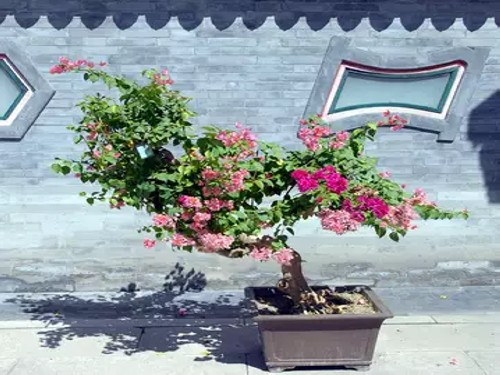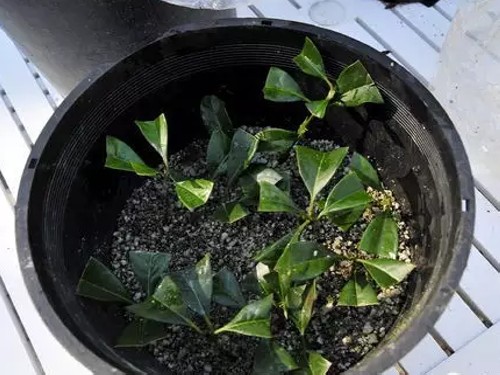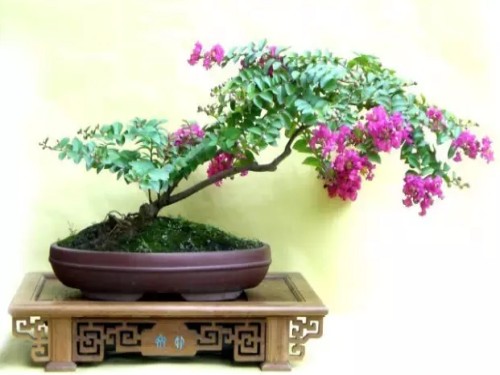Modeling method of crape myrtle bonsai
Crape myrtle has been a very good bonsai tree since ancient times, and it is one of the pile scenery "Rocks of Eighteen Scholars". It is widely used in the Huizhou School and Sichuan School of the traditional eight pile Landscape Schools. Crape myrtle has the characteristics of exposing its roots, and the older the tree is, the more Qiu qu its roots are, which has a vigorous, simple, elegant and finishing effect. Many crape myrtle bonsai make good use of its root-revealing characteristics. Bonsai production should try every means to simulate the roots of crape myrtle, so as to make the works have natural wild interest.
Crape myrtle enters the shade shed management after potting, and can be restored to life in 15 days. Crape myrtle stem is finer, so the bonsai made by small seedlings adopt more dry twisting method to thicken the trunk. That is, the use of crape myrtle rhizosphere sprouting branches, one by one along the trunk into a spiral winding, after 1-2 years, the branches and trunk can heal together, become a whole, and appear old and simple.

Crape myrtle is resistant to pruning, strong branching ability and large shoot growth. Therefore, the residual flowers should be cut off after flowering, which can prolong the flowering period and cut off the overgrown branches, overlapping branches, crossed branches, radiant branches and diseased branches at any time so as not to consume nutrients. If the seedlings of different colors are planted together in a hole, the base is tied together to make the trunk wind around each other, the same effect can be formed after 2-3 years. The branches of crape myrtle are long and slender, which are not suitable for excessive distortion. Generally, pruning and shaping can be used to make them more beautiful.
1. The bonsai made from crape myrtle seedlings can be thickened by multi-stem (branch) twisting method. The sprouting branches in the rhizosphere of crape myrtle were spirally wound along the trunk one by one and fixed with string to prevent them from loosening. After 2-3 years, the branches and trunk can heal together, become a whole, make the trunk thicken obviously, and appear old and simple; also can plant a hole of crape myrtle seedlings of different colors, the base is tied together with brown silk, the trunk is entangled with each other, twisted together, fixed with string, after 3-4 years, the trunk forms vigorous, simple and sturdy, and the same plant is rich in flowers and colors, unique.
2. The pruning and shaping of crape myrtle is generally carried out by an intensity pruning in winter, keeping the branches evenly distributed and the crown intact during pruning, cutting off the overdense branches and the sprouting branches on the stem and inappropriate branches, cutting the long branches by 2 seconds 3, and generally keeping the branches about the 6cm of the previous winter cut. When the new branches grow to about 15cm in spring, the coring is carried out and the lower 10cm is retained to promote the growth of the two bifurcated branches at the top. When the two forked branches grow to about 20cm, the coring is carried out and the lower 15cm is retained to promote the germination of new branches and remove all the other branches that affect the ornamental and shape. After the pruned branches grow into sequence, the weaker flower branches and buds that have nothing to do with shape are cut off. Cut off the residual flowers after blooming. If properly pruned, the flowers can bloom until around the National Day.
3. Crape myrtle is a deciduous tree species, which begins to shed its leaves in mid-October under natural conditions. in order to prolong the viewing period after flowering, the old leaves can be removed in early September. Note that when picking leaves, the leaves on a branch can not be removed at once, but should be removed in batches. After picking leaves, always spray water on the branches and the rest of the leaves. New leaves will be issued in 15-20 days, and the new leaves will be small, red, thick and shiny. The unlignified branches are all purplish red, which can be seen until December, and does not affect the flowering and leaves of the following year.
4. Crape myrtle branches are long and slender, so the method of "combination of pruning and binding" should be adopted, the main trunk and branches should be properly tied, and the other lateral branches should be trimmed and reshaped. Panza often chooses brown silk. The bark of crape myrtle is easy to be bruised by wire tying, so it is not suitable for use. Panza time is mostly selected from late autumn to early spring of the following year.
5. In order to make the smooth and smooth crape myrtle bark show old and mottled love, in the peak growth period, cut or hit the local bark with a knife and axe, coat the xylem with stone-sulfur mixture, the right to use it is whitened, giving people the feeling of weather and frost, and the branches can also be split, broken, twisted, etc., after the callus is grown, the trunk will be covered with tumors, showing a state of aging, and the smooth crape myrtle stake can also be made. Use a sharp axe to cut off large chunks (depending on the size of the stump and the creative idea and conception) to carve the exposed xylem with electric drills and wooden chisels to make it show a natural decaying form. After the large pile pieces split are treated with rooting powder and fungicides, they are cut in the nursery, keep the basin soil moist, pay attention to shade, and make them take root and sprout normally, which can be put on the pot in 1-2 years. Small or miniature dry bonsai can be made by this method.
Shaping and pruning:
1. The general shaping and pruning of crape myrtle bonsai should be based on the need of bonsai shaping after defoliation, and 1-2 buds per branch should be re-cut.
2. In the growing season, pruning mainly removes dense branches, overgrown branches that go around the tree shape, and worthless branches germinated on the basal stem, which should be erased or cut off in time.
3. In order to make crape myrtle bonsai blossom many times and bloom well within a year, the residual flowers should be removed in time after each flower shedding, so as to prevent fruit, promote the rapid expansion of secondary buds and blossom many times, but the flowering period is not neat first and then not neatly. In addition, if there are not many secondary buds after the flower fade, each branch leaves 1-2 buds for re-pruning, generally 14 days to show buds, 35 days or so can be full of trees and flowers, which can make crape myrtle bonsai branches thicker and shorter (the average branch length is less than 15 cm), the tree shape is very compact, and the flowers are colorful and pleasing to the eye.
4. Pull branch, support branch, take branch. These three techniques are mainly from May to October, according to the modeling needs of crape myrtle bonsai, regulate and control the branches of crape myrtle bonsai, increase and control the angle of branches, and adjust the angle of branches at will, so as to concentrate nutrients and accumulate nutrients. especially when some branches of crape myrtle bonsai are pulled, supported and used, some of the branches are arched. Many very short twigs (less than 10 cm) grow on its arched back, which not only greatly increases the number of flowering branches and buds, but also the color of crape myrtle is very beautiful.
Time: 2019-06-10 Click:
- Prev

Cutting technique of Camellia
Camellia, also known as Camellia, belongs to the genus Camellia of Theaceae. Camellia flower is rich, dignified and elegant, which is one of the top ten traditional flowers in China and one of the famous flowers in the world. Camellia is very convenient to manage as long as the temperature is right, and its dislike of fertilizer makes daily management easier. Sex likes a warm, humid environment.
- Next

How to trim crape myrtle bonsai
Crape myrtle is a very interesting flower tree, it has a characteristic: crape myrtle blossoms for a hundred days, gently caressing the branches and stems of the whole tree. Therefore, crape myrtle is also known as the itching tree. Crape myrtle has beautiful appearance, flexible branches and bright flowers, and blossoms in summer and autumn. It is an important ornamental tree species in summer and autumn.
Related
- Fuxing push coffee new agricultural production and marketing class: lack of small-scale processing plants
- Jujube rice field leisure farm deep ploughing Yilan for five years to create a space for organic food and play
- Nongyu Farm-A trial of organic papaya for brave women with advanced technology
- Four points for attention in the prevention and control of diseases and insect pests of edible fungi
- How to add nutrient solution to Edible Fungi
- Is there any good way to control edible fungus mites?
- Open Inoculation Technology of Edible Fungi
- Is there any clever way to use fertilizer for edible fungus in winter?
- What agents are used to kill the pathogens of edible fungi in the mushroom shed?
- Rapid drying of Edible Fungi

